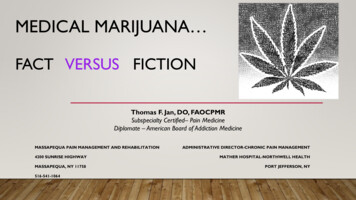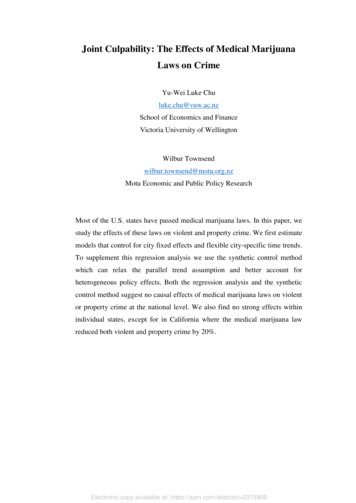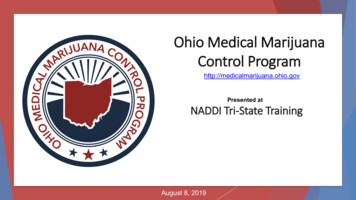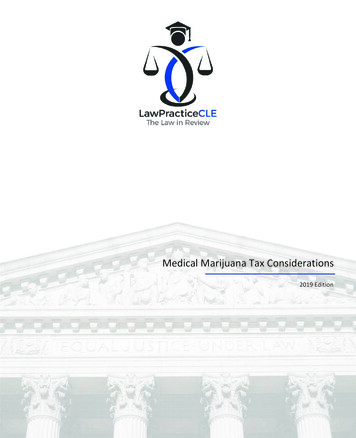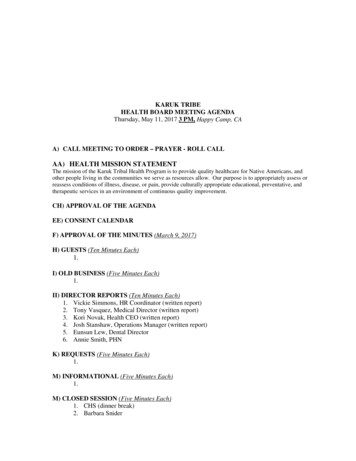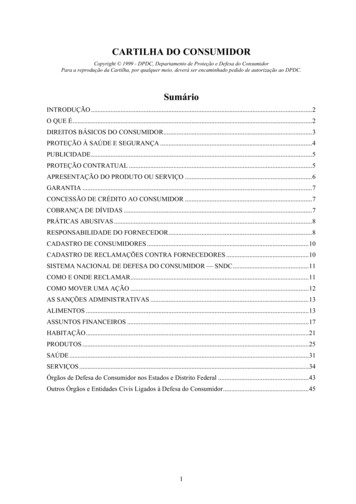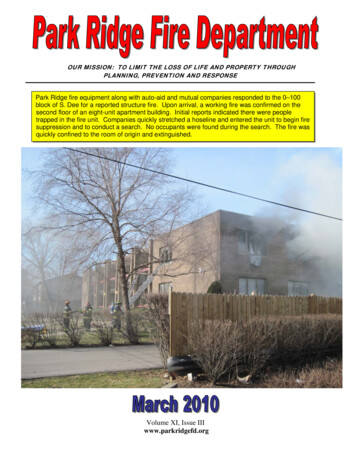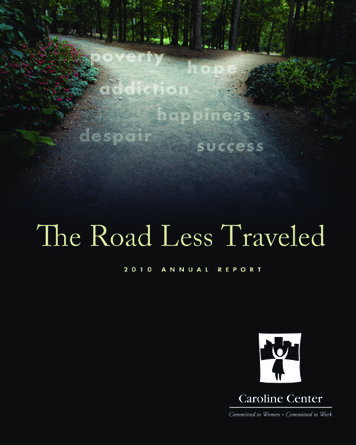
Transcription
Our MissionFamilies Against Mandatory Minimums (FAMM) was established in 1991 to rollback the onslaught of mandatory minimum sentencing laws and promote fairand proportionate sentencing policies.Through lobbying, advocacy, litigation, and media outreach, FAMM educates legislators and the public about the harm caused by mandatory minimum sentences. FAMM’s membership includes over 14,000 individuals and families,including many whose lives are adversely affected by mandatory sentences.Our VisionFAMM's vision is a nation in which sentencing is individualized, humane,and sufficient but not greater than necessary to impose just punishment,secure public safety, and support successful rehabilitation and reentry.Contact FAMMFamilies Against Mandatory Minimums1612 K Street NW, Suite 700Washington, DC 20006Tel: (202) 822-6700Fax: (202) 822-6704Email: famm@famm.orgWebsite: www.famm.org
Correcting Course:Lessons from the 1970 Repealof Mandatory Minimums
About the AuthorMolly M. Gill is the Staff Attorney and Special Projects Director for Families Against MandatoryMinimums (FAMM). Before working in sentencing reform, she served as the Gang Unit Law Clerkfor the Hennepin County Attorney’s Office in Minneapolis, Minnesota and later practiced corporateand construction litigation. She has a law degree from the University of Minnesota Law School anda bachelor’s degree from Oral Roberts University.AcknowledgmentsFor their generous assistance, many thanks are due to FAMM board member Eric Sterling andFAMM intern Lenora Yerkes and to Leon Greenfield, Perry Lange and Edward Sharon of theWashington, D.C. law office of WilmerHale. This report was designed by Lucy Pope at 202designand produced with the financial support of the William D. Smythe Foundation and David H. Koch.
Table of ContentsExecutive Summary2Introduction5The Boggs Act: Congress Adopts Mandatory Minimums7Drug Mandatory Minimums are Tried – And Fail – Again18Time to Correct Course29Recommendations for Reform31Conclusion32Endnotes331
Executive SummaryThe United States has the largest prison population in the world. Many of theseoffenders are not murderers, robbers, or rapists, but drug users, addicts, or sellers. Every year, thousands receive lengthy mandatory terms in federal prisonsfor these drug crimes. The mandatory sentences on the books today were designed tostop drug trafficking, but they have not. It is not the first time in American history thatthey have been used and failed.In 1951, Congress established mandatory minimum prison sentences for drug crimes.Named for its sponsor, Representative Hale Boggs (D-La.), the Boggs Act imposed twoto-five year minimum sentences for first offenses, including simple possession. The Actmade no distinction between drug users and drug traffickers for purposes of sentencing.The driving force behind the Boggs Act was a mistaken belief that drug addiction was acontagious and perhaps incurable disease and that addicts should be quarantined andforced to undergo treatment. Just five years after the Boggs Act, Congress passed theNarcotics Control Act of 1956. The new law increased the Boggs Act’s minimum prisonsentences for drug offenses.Far from slowing the rise in drug use among America’s youth, the strict antidrug lawswere followed by an explosion in drug abuse and experimentation during the 1960s. Thegrim statistics during that period confirmed that mandatory minimum sentencing lawswere simply not working. Correctional professionals, including prison wardens andjudges, expressed opposition to the mandatory sentences.The Prettyman Commission established by President John F. Kennedy and theKatzenbach Commission created by President Lyndon B. Johnson were both created to2
study ways to reduce drug use. They found that long prison sentences were not an effective deterrent to drug users, that rehabilitation should be a primary objective for the government, and that courts should have wide discretion to deal with drug offenders.President Richard Nixon took office in 1969 determined to curtail the growing drug problem. Rather than add new arbitrary and harsh mandatory sentences, the NixonAdministration and Congress negotiated a bill that sought to address drug addiction throughrehabilitation; provide better tools for law enforcement in the fight against drug traffickingand manufacturing; and provide a more balanced scheme of penalties for drug crimes. Thefinal product, the Comprehensive Drug Abuse Prevention and Control Act of 1970, repealedmandatory minimum drug sentences except in limited and serious circumstances.The Act was praised by both Republicans and Democrats in Congress. ThenCongressman George H.W. Bush (R-Texas) spoke in favor of the repeal because it would“result in better justice and more appropriate sentences.” Supporting the repeal of drugmandatory minimums exposed members of Congress to no political jeopardy. Indeed,every senator, save one, and all but a handful of House members who voted for repealwon re-election. There is no evidence to suggest that any of the small number of defeated members lost because of their vote for repeal.In the mid- and late- 1980s, Congress reinstated mandatory minimum laws. This time,Congress was reacting, in part, to the high-profile drug overdose of basketball star LenBias. The new laws were enacted without any hearings, debate, or study.Today, after 20 years of experience, it is clear that the current mandatory minimumshave failed as badly as those enacted in the 1950s. The evidence leads to the followingconclusions about mandatory minimum sentences: They have not discouraged drug use in the United States. They have not reduced drug trafficking.3
They have created soaring state and federal corrections costs. They impose substantial indirect costs on families by imprisoning spouses, parents, and breadwinners for lengthy periods. They are not applied evenly, disproportionately impacting minorities and resulting in vastly different sentences for equally blameworthy offenders. They undermine federalism by turning state-level offenses into federal crimes. They undermine separation of powers by usurping judicial power.These problems have caused many former prosecutors, federal judges, and legal commentators to speak out against mandatory minimums. A report by the nonpartisanFederal Judicial Center, the education and research arm of the federal courts, concludedby agreeing with the findings of sentencing expert Michael Tonry, who said that “[a]sinstruments of public policy [mandatory minimums] do little good and much harm.”1States are leading the reform effort with bipartisan repeals of their own mandatory sentencing policies and by turning to drug courts and other alternative solutions.Today’s Congress, as the 91st Congress did in 1970, should reform mandatory minimumsentencing. This report presents two options: excise all mandatory minimums for drugoffenses found in the criminal code or expand the existing “safety valve” to allow judges todepart from the statutory sentence when that punishment would be excessive. Either solution will result in better and more cost effective criminal justice and pave the way forsmarter alternatives.4
Introduction“All men make mistakes, but a good man yields when he knows his courseis wrong, and he repairs the evil,” Sophocles once wrote.2 In 1970,Congress proved it had enough wise and good men and women to dosomething unusual – repeal a tough criminal law that it had passed 20 years earlier. By1970, Congress had learned that the mandatory minimum prison sentences it hadpassed in the 1950s to combat drug trafficking crimes were a mistake. These laws failedto reduce drug trafficking or drug use, as their proponents had claimed they would.A mandatory minimum sentence is a required minimum term of punishment (typicallyincarceration) that is established by Congress or a state legislature in a statute. When amandatory minimum applies, the judge is forced to follow it and cannot impose a sentence below the minimum term required, regardless of the unique facts and circumstances of the defendant or the offense.In 1951, Congress adopted the Boggs Act, named for its sponsor, Representative HaleBoggs (D-La.), which imposed harsh mandatory minimum sentences on those convictedof drug crimes. Five years later, Congress added even more punitive sentences, includingthe death penalty for drug sales to a minor.Over the next decade and a half, drug use soared. The tough new laws did little to deterdrug trafficking and abuse, as both juvenile and adult drug usage rates exploded duringthe 1960s. By the end of the decade, drug use had moved out of the cities, into suburbia,and onto campuses. Seemingly convinced that mandatory minimum sentences for drugoffenders were ineffective, a broad, bipartisan majority in Congress voted to repeal nearly all such sentences in 1970.5
Today, federal lawmakers face the same dilemma that their predecessors in the 91stCongress faced. In the 1980s, Congress responded to the media frenzy around the crackcocaine epidemic by enacting two anti-drug crime bills containing new mandatory minimum sentences. Twenty years later, the results are in: the new penalties have failed.These mandatory sentences are no more effective than the similar sanctions adopted inthe 1950s. The question now is simple: Will members of Congress follow the exampleset by their predecessors in 1970 and eliminate mandatory minimums, or will they continue to stand by a costly failed experiment?To better educate members of Congress and the American public about the choice athand, this report presents the history of the Boggs Act and its repeal. It then examinesthe record of the mandatory minimums that were enacted in the mid-1980s and findsthat they have failed for the same reasons as the mandatory sentences in the Boggs Act.The report concludes that the current Congress should follow the example of the 91stCongress in 1970, correct course, and vote once again to reform mandatory minimumsentences.6
The Boggs Act: CongressAdopts Mandatory MinimumsSince the founding of this nation, Congress has responded to public concernabout particular crimes by passing tough mandatory sentencing laws. For example, as early as 1790, piracy triggered a mandatory sentence of life in prisonwithout parole. Many of these older mandatory sentences are still on the books.3One noteworthy exception is the Boggs Act, which codified tough mandatory drug sentences in 1951 and was repealed in 1970. The history of these sentences and their repealis worth revisiting because it holds valuable lessons for us today.The Boggs Act of 1951 first codified mandatory minimum sentences for the possessionor sale of narcotics.4 Findings from the heavily-publicized hearings of the SenateSpecial Committee to Investigate Organized Crime in Interstate Commerce revealed agrowing trend in American society – drug addition and trafficking were increasing atalarming rates, particularly among young people.5 Representative Hale Boggs (D-La.)observed, “We need only to recall what we have read in the papers this past week torealize that more and more younger people are falling into the clutches of unscrupulousdope peddlers.”6The Boggs Act attempted to curtail the use and distribution of drugs with strict minimum sentences and fines for violators. A first offense – even for simple possession without intent to distribute – carried a minimum two-to-five year prison term. A secondoffense carried prison terms of five-to-10 years, and a third offense carried a sentence of10-to-15 years.7 The Act made no distinction between drug users and drug traffickers forpurposes of sentencing.7
Boggs ActDriving this and otherSentences for drug crimes*antidrug laws adoptedFirst offenseSecond offenseThird offense2 to 5 years5 to 10 years10 to 15 years*The offense could include everything from simple possession to drug trafficking.during the period wasFederal Bureau ofNarcotics CommissionerHarry J. Anslinger.8Citing rising addictionand violence among juve-niles, Anslinger argued that soft-hearted judges were to blame. Long prison sentences,not rehabilitation, were what young addicts needed.9 Anslinger described drug addicts asincurable, “spread[ing] addiction wherever they are, contaminat[ing] other persons likepersons who have smallpox.”10 Public education efforts, Anslinger said, would encourage, not deter, drug use by young people. This was one of the few points Anslinger madeduring his testimony that drew disagreement from the investigating committee.11Anslinger’s answer to the growing abuse problem was simple: Congress should passlengthy mandatory minimum prison terms for nearly all drug crimes.12 At a time whenaddiction was not well understood, Anslinger’s idea proved popular, especially amongmembers of Congress who got a chance to show their constituents that they were toughon crime. The Boggs Act passed easily.13In 1955, four years after the Boggs Act became law, another Senate subcommittee, headed by Senator Price Daniel (D-Texas), launched a nationwide investigation into the trafficand sale of illegal narcotics.14 Records of the investigation demonstrate the lack of understanding many senators had about drugs. When asked by a member of the subcommittee, Anslinger confirmed the “fact” that marijuana users “ha[ve] been responsible formany of our most sadistic, terrible crimes in this Nation, such as sex slayings, sadisticslayings, and matters of that kind.”15 The subcommittee’s report concluded that “[d]rugaddiction is contagious. Addicts, who are not hospitalized or confined, spread the habitwith cancerous rapidity to their families and associates.” The solution was compulsory8
treatment, and, for those who failed to respond to such treatment, “place[ment] in quarantine type confinement or isolation.”16 When the subcommittee’s investigation ended, itissued reports finding that the United States had more drug addicts than an
Website: www.famm.org. Correcting Course: Lessons from the 1970 Repeal of Mandatory Minimums. About the Author Molly M. Gill is the Staff Attorney and Special Projects Director for Families Against Mandatory Minimums (FAMM). Before working in sentencing reform, she served as the Gang Unit Law Clerk for the Hennepin County Attorney’s Office in Minneapolis, Minnesota and later practiced .
